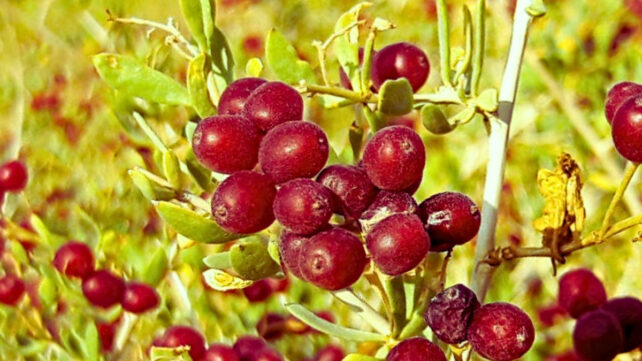A berry used in traditional folk medicine holds a remarkable power to restore healthy fat metabolism as well as insulin sensitivity in a diabetes model in mice.
These tiny red fruit come from a little-known shrub called Nitraria roborowskii Kom. (NRK), which grows in the dry temperate regions of Western and Northern China, Mongolia, and Iran.
They have a long history in local folk medicine, and scientists suspected that modern pharmacology could explain why.
Related: Experts Reveal a Drug-Free Way to Mimic The Effects of Ozempic
A plant from the same genus, Nitraria tangutorum, has already been found to lower blood levels of lipids and glucose in animal models, so a team led by Di Wu of Qinghai University in China tested whether NRK could have similar effects.
A concentrated extract of the berry given to diabetic mice not only normalized their blood sugar levels, but also improved their lipid (fat) metabolism and reduced oxidative stress associated with diabetes.
The breadth of effects is rarely seen in single manufactured drugs, the authors note, which suggests the berry extract may be fundamentally resetting the body's underlying metabolic issues, rather than acting on individual symptoms.
"These results are exciting because they suggest we might be able to treat diabetes more holistically," explains organic chemist Huilan Yue, from the Northwestern Institute of Plateau Biology in China.
"Instead of just lowering blood sugar like most medications, this plant extract appears to help the body regain its natural metabolic balance. The implications could extend beyond diabetes to other conditions involving insulin resistance."
Eighty male mice were divided into groups at random: 14 were assigned to a control group, fed normal chow, and 65 were part of the model type-2 diabetes group, in which they were fed high-sugar and high-fat chow and injected with streptozotocin, to kill off the insulin-producing cells in their livers (one mouse didn't make it to the main experiment).
Among the 'diabetic' mice, some were given no treatment, some were given metformin (a common diabetes medicine), and the rest were treated with low, medium, and high doses of concentrated NRK extract.
Across seven weeks, the scientists measured the animals' weights and fasting blood glucose levels. After this period, the mice were killed so their blood and organs could be inspected more closely.

This revealed the diabetes model had, as expected, significantly elevated levels of blood lipids, triglyceride (the main component of body fat), overall cholesterol, and low-density lipoprotein-C (the 'bad' cholesterol that, in excess, causes cardiovascular disease).
A medium to high dose of concentrated NRK extract, however, brought those levels back down.

The diabetes model also significantly decreased blood levels of high-density lipoprotein-C (commonly referred to as a 'good' cholesterol), which was restored among the mice given a high dose of NRK extract.
"Thus," the authors report, "the lipid metabolism disorder was significantly improved."
The berry extract also lowered fasting blood glucose by 30-40 percent in diabetic mice, with the impact clearly increasing with higher doses. And, compared to diabetic mice not treated with the extract, insulin sensitivity was restored in NRK-treated mice by nearly 50 percent.
Their internal organs were also in far better shape by the end of the experiment, with their liver and pancreas seemingly protected from the damage that induced diabetes wrought on untreated mice.
Related: Our Brains Evolved Powerful Mechanisms To Protect Our Weight
"Despite the increasing number of drugs related to the treatment of type 2 diabetes, many of them lead to drug tolerance and side effects affecting the health of the organism," the authors explain.
NRK could "significantly improve fasting blood glucose levels, glucose tolerance, hepatic glycogen levels and lipid levels, and significantly [reduce] insulin resistance of diabetic mice."
"All these results suggested that [concentrated NRK extract] might be a potential drug for improving insulin resistance and reducing hyperglycemia in type 2 diabetes," they conclude.
This research was published in Chinese Journal of Modern Applied Pharmacy.
